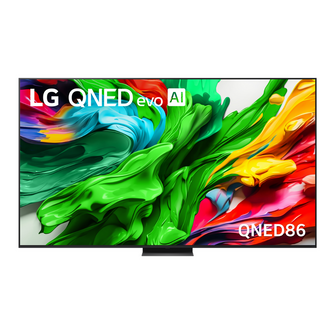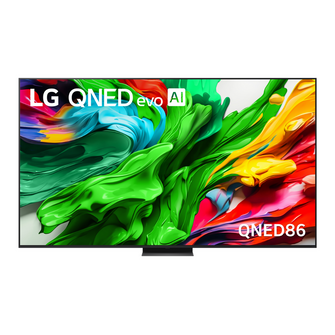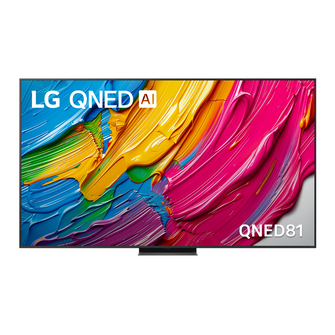QNED stands for Quantum Nano Emitting Diode, and it's LG’s premium LED TV tech. QNED combines the Quantum Dot, NanoCell and Mini LED technologies into one panel to create a bright, colourful picture.
Think stunning contrast, more precise brightness control, and way better viewing angles than your old LCD. QNED sits between QLED and OLED in terms of picture quality, and it’s designed to perform brilliantly in bright rooms.
To put it simply, QNED is LG’s way of squeezing high-end colour and clarity out of a traditional LED TV panel using quantum dots technology.
How Does QNED Work?
QNED is a three-part tech sandwich:
- Quantum Dot tech uses billions of nano-sized crystals that glow when hit by light, producing brighter, more accurate colours.
- NanoCell acts like a colour filter, it blocks out dull tones to deliver purer reds, greens, and blues. This helps every colour look more vivid and lifelike.
- Mini LED backlighting swaps out the big, bulky lights found in older TVs for thousands of much smaller ones. That means better contrast, more precise brightness control, and way less of that annoying “halo glow” you get around bright objects on dark backgrounds.
Put them all together and you get a screen with rich colour, sharp detail, and deeper blacks — especially thanks to LG’s local dimming tech that reduces light bleed and halo effects.

QNED vs Other TV Technologies
If you’re confused about whether QNED is better than OLED, QLED, or LED LCD, here’s the no-nonsense breakdown:
QNED vs LED LCD
LED LCD TVs are what most people have had at some point — they use a standard LED backlight with older LCD panel tech and basic colour filters. They’re usually affordable but often lack depth, accuracy, and true contrast.
QNED takes this concept and supercharges it with Mini LED precision, enhanced colour layers, and smarter dimming. The difference in clarity, colour, and brightness is massive.
QNED vs QLED TVs
QLED TVs, mainly from Samsung, Hisense and TCL, use Quantum Dots to enhance colour on top of an LED backlight. They’re bright and bold, but still suffer from backlight issues like haloing or light bleed. QNED includes both Quantum Dot and NanoCell filtering, plus Mini LED for more precise lighting.
QNED vs OLED TVs
OLED TVs are in a league of their own when it comes to black levels. Each pixel lights up independently, so there’s no backlight at all. That means perfect contrast, rich detail in dark scenes, and very wide viewing angles. OLED panels are carbon-based and self-lighting, giving you unbeatable performance in dark rooms.
That said, QNED holds its own. It still uses a Mini LED backlight, but the advanced layering of Quantum Dot and NanoCell — plus LG’s dimming tech — means it performs especially well in bright rooms where OLEDs can sometimes struggle. And it's typically more affordable.
Because QNED panels use a backlight, they’re also less prone to burn-in than OLED technology — great news if you leave your console paused or binge the same news channel for hours.
If you want cinema-level depth and don’t mind the price tag, go OLED. If you want something a bit more budget-friendly that still delivers top-tier performance for sport, gaming and everyday watching, QNED is your go.

Why Choose LG QNED TVs?
LG was the first to bring this exact combo of Quantum Dot, NanoCell and Mini LED together, and it shows. Their dimming tech uses AI to figure out where light should go and where it shouldn’t. That means less light bleed, sharper objects on screen, and better clarity in fast-moving scenes.
You also get LG’s own ThinQ AI, WebOS smart platform, and powerful image processing. Everything loads fast, looks smooth, and sounds decent straight out of the box.
What Is QNED Good For?
I use my TV screen for everything:
- Playing first-person shooters at 2am while whisper-shouting abuse at strangers online.
- Watching beautifully shot Oscar-bait movies
- Screaming internally (and sometimes externally) at the bunker while watching football.
- Falling asleep mid-docuseries about cults or scammers or whatever we’re all obsessed with this week.
The picture quality stays sharp no matter what. For gaming, QNED supports NVIDIA GeForce Now, high frame rates, and low input lag, keeping up when things get chaotic. For sport, wide viewing angles and vivid colour mean you can see everything clearly.
And for film lovers, LG’s Filmmaker Mode strips away motion smoothing and image tampering so you see the movie as the director actually intended. No more soap opera effect!

The Wrap-Up: Why You’ll Love QNED
QNED is one of those rare TV technologies that actually lives up to the hype. With Quantum Dot colour, NanoCell filtering, Mini LED precision and AI-powered dimming, the result is something seriously special.
Check out the latest QNED range at Bi-Rite. Whether you’re into games, movies, footy, or the latest cult doco, LG QNED is ready to feast your eyeballs in glorious colour and clarity. Just try not to stay up too late playing shooters. I’m working on that part myself.














